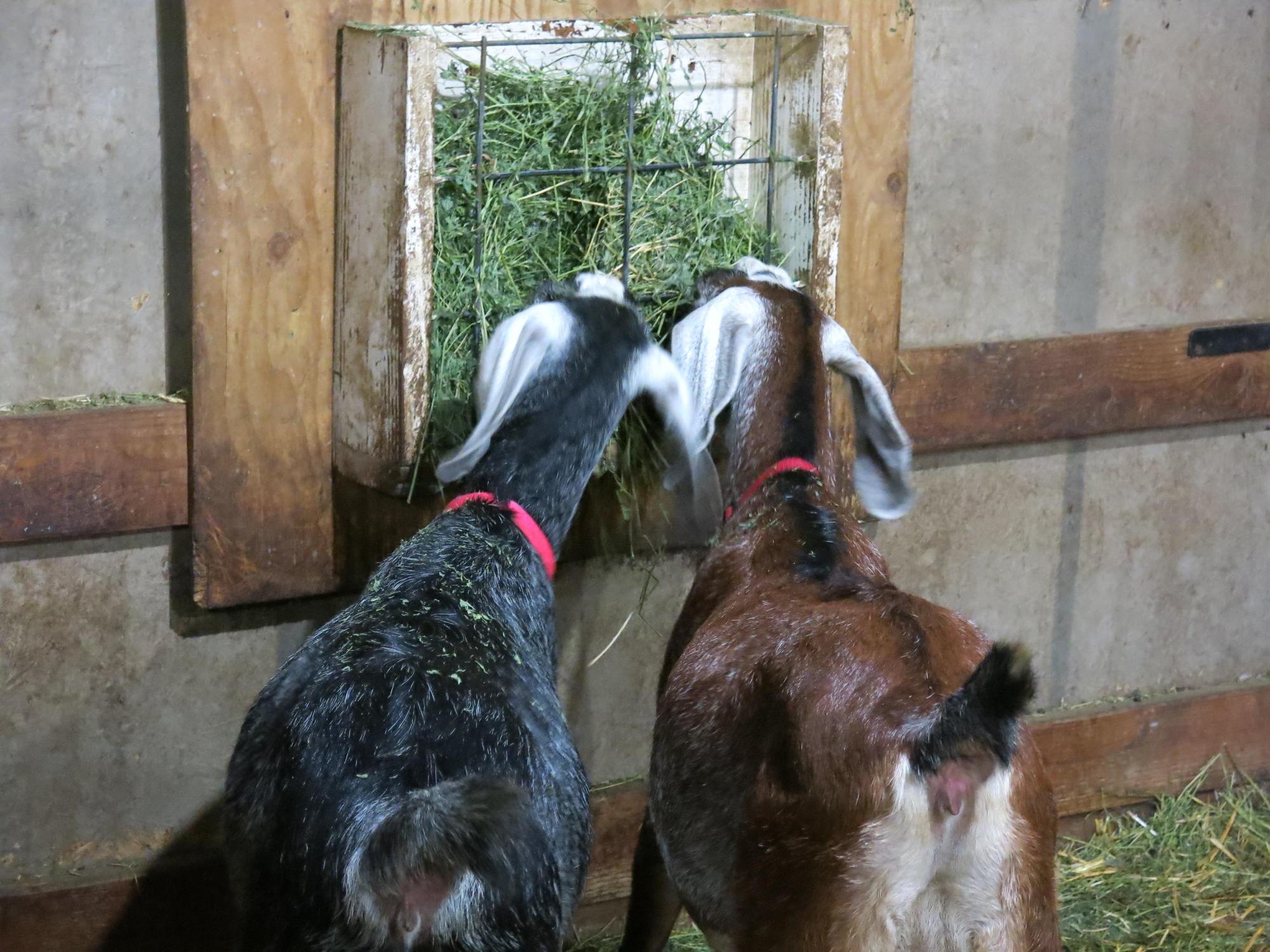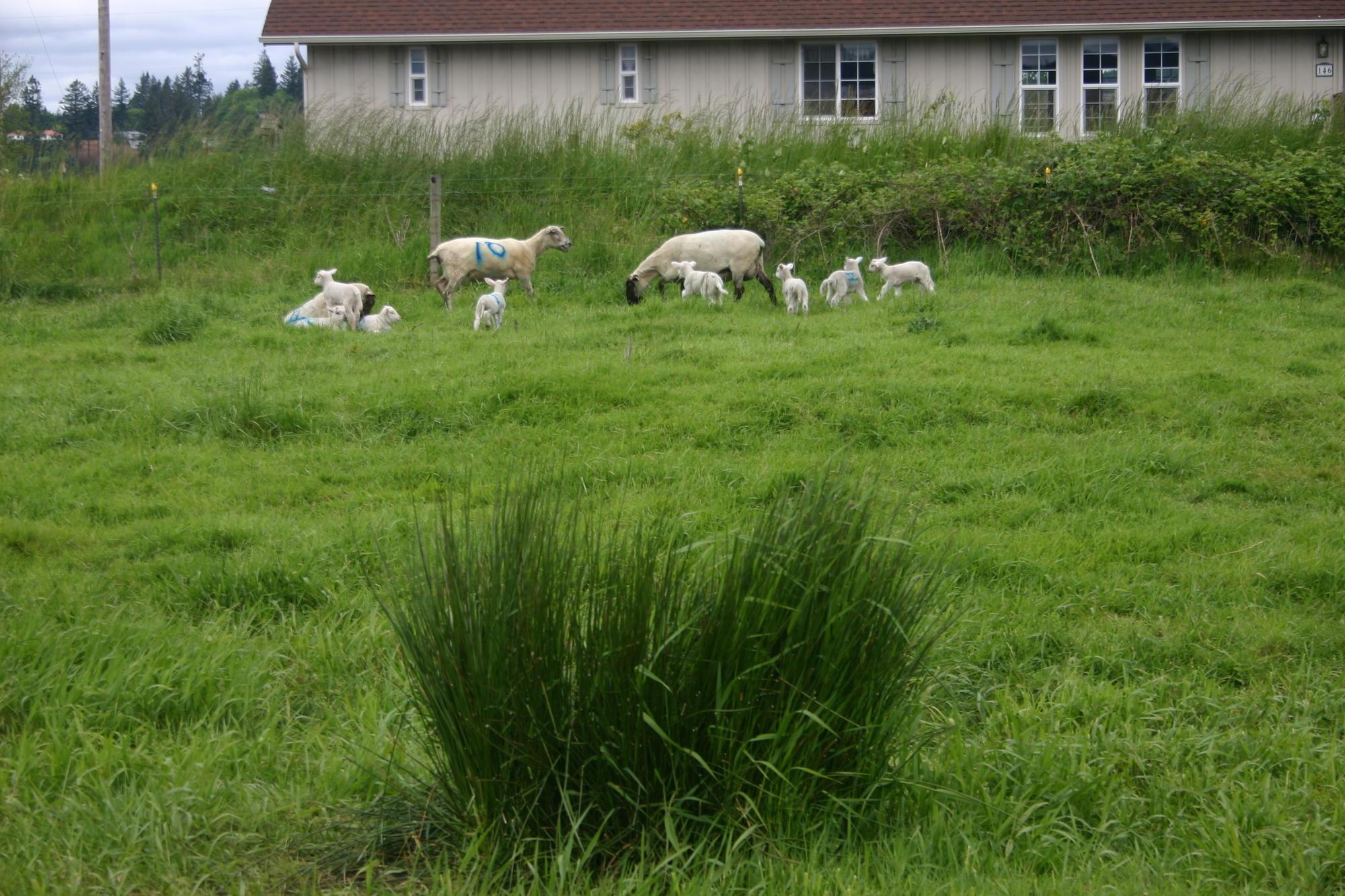The Five Nutrients
Sheep and goats require five essential nutrients: water, energy (carbohydrates and fat), protein, vitamins, and minerals. A deficiency in any of these can cause illness, poor growth or performance, and even death. Signs of a good diet include rapid growth, high reproductive success, normal manure, good body condition, high milk production, and alert behavior. Hungry animals eat continuously and do not rest, chew cud, or play.
Minerals required for animal health
- Sodium (Na)
- Selenium (Se)
- Chloride (Cl)
- Copper (Cu)
- Calcium (Ca)
- Iron (Fe)
- Phosphorus (P)
- Zinc (Zn)
- Sulfur (S)
- Iodine (I)
- Potassium (K)
- Manganese (Mn)
- Magnesium (Mg)
- Cobalt (Co)
- Molybdenum (Mo)
Ruminant Digestion
Sheep and goats are ruminants with a specialized digestive tract. Beneficial microorganisms in the rumen produce enzymes that break down plant material and make nutrients available for fermentation. The nutrients, fermentation byproducts, and microbes are energy and protein sources for the sheep or goat. A forage-based diet is important to keep the rumen and the animal healthy.
Any changes in diet should happen gradually over a week or two, so the animal and microbes can adapt. Otherwise, the animal’s digestion will be disrupted, reducing metabolism of the feed and possibly making the animal ill.
Types of Feed
Forage is fibrous plant material. It can be fresh, dried, or fermented. Examples are grasses and legumes (pasture), shrubs (browse), and hay. Most small-scale producers do not use fermented feeds (silage). Forages provide both protein and energy at a lower cost, but they can vary in their nutritional quality. Quality depends on the plant’s maturity at the time of harvest, plant species, soil fertility, weather, available water, and storage method.
Concentrates are high-energy grains such as corn, oats, wheat, barley, and sorghum. They can also be pellets of high-energy, high-protein commercial blends of feeds that meet a specific nutritional need. Molasses, soybean meal, seed cake, tallow, and fishmeal are common in concentrate pellets. Concentrates generally are more expensive than forages.
Do Sheep and Goats Need Grain?
Most adult sheep and goats can maintain themselves on good quality grass hay, minerals, and water. Growing, late-pregnant, and lactating animals need nutritional supplements or they will not meet their potential for growth, live offspring, or milk production (Photo 2). Sheep bred for wool may need protein supplements to support fleece production on lower-quality grass. Be sure to add any concentrates gradually to the diet, and feed them two or more meals daily.
Feeding Behavior
Browsing is eating at eye level or above, and grazing is eating with the head down. Both sheep and goats can do both, but goats prefer to browse and sheep prefer to graze (Photo 1).
It is difficult to establish browse plants for goats. It’s best to let them eat unwanted plants such as poison oak, English ivy, Himalayan blackberries, and multiflora rose. Be sure to supplement browse diets with extra forage or concentrate to meet nutritional needs.
Do not allow livestock to graze pasture below 3 inches tall. Most parasite larvae reside there and are a significant health threat if ingested. Preserving the lowest 3 inches of grass also benefits pasture regrowth and long-term forage production.
Nutritional Concerns
Pregnancy ketosis is common in sheep and goats. This condition typically arises late in an animal’s pregnancy when there are several rapidly growing fetuses. To prevent ketosis, feed sheep and goats in the last third of pregnancy a diet that gradually increases in energy content. A good guideline is to start slowly, 6 weeks before kidding and lambing, at about ¼ pound of energy concentrate per pregnant dam per day, until you are feeding 1 pound per fetus by the time of kidding and lambing.
Acidosis is a common disorder among sheep and goats when their owners are inexperienced. It is caused by improper feeding of high-energy diets. Chronic acidosis can manifest as appetite loss, loose feces, founder, and reduced health and growth. Severe acidosis can be fatal. To prevent this condition, make dietary changes gradually and do not overfeed grain or concentrates.
Vitamin and mineral imbalance can cause milk fever, white muscle disease, blindness, softening of the brain, rickets, retained placenta, miscarriage, and death.
Urinary tract stones are a serious concern for wethers. Prevent these conditions with proper mineral and vitamin intake. Sheep are sensitive to copper, so be sure your mineral supplement is formulated specifically for them.
Toxic plants are another threat to sheep and goat health. Although livestock generally avoid eating bitter plants, they do not “know” which plants are toxic. To protect your animals, identify and eliminate the toxic plants in your pastures and buy weed-free hay. Your local Extension educator or weed control supervisor can often help identify weeds and explain how to control them.
Feeding a Balanced Diet
You can send samples of hay or other forage to a laboratory for chemical analysis. You can use the results to create a balanced diet for your sheep and goats. Consult your veterinarian, Extension educator, or livestock nutritionist for assistance.
Resources
Caretakers of sheep and goats are strongly encouraged to learn more about nutrition and feeding from these resources, veterinarians, Extension educators, and nutrition consultants.
- List of chemical analysis laboratories in the PNW
- Feeding sheep
- Feeding goats
- Interpreting hay analyses
The phrase “Living on The Land” is used with permission from Living on The Land Stewardship for Small Acreage, © 2008, UNCE/WSARE.
Listen to our Living on The Land podcasts.

